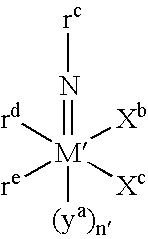Norbornene ring-opened polymer hydrogenated product and process for producing same
- Summary
- Abstract
- Description
- Claims
- Application Information
AI Technical Summary
Benefits of technology
Problems solved by technology
Method used
Image
Examples
preparation example 1
[0112] A glass reaction vessel equipped with a stirrer was charged with 1.35 parts of tungsten (2,6-dimethylphenylimide)tetrachloride and 21 parts of diethyl ether. The mixture was cooled to −78° C. Then, 0.74 parts of 3,3′,5,5′-tetramethyl-2,2′-biphenol dissolved in 21 parts of diethyl ether was added. The temperature was gradually increased to 0° C. and reacted for 24 hours, while maintaining the temperature at 0° C. After the reaction, diethyl ether was evaporated to obtain a dark purple red solid product.
[0113] After the addition of 13 parts of hexane and 4.2 parts of diethyl ether to the solid product, the mixture was cooled to −78° C., at which temperature, the mixture was allowed to stand for one hour to cause insoluble materials in the form of fine crystals to precipitate. The soluble portion was separated by filtration. The remaining insoluble portion was washed with 6.6 parts of hexane and the solvent was evaporated to obtain 1.84 parts of a compound (a).
[0114]1H-NMR spe...
preparation example 2
[0117] 1.34 parts of a compound (b) was obtained in the same manner as in Preparation Example 1, except for using 1.13 parts of tungsten (phenylimide)tetrachloride diethyl ether complex instead of 1.35 g of tungsten (2,6-dimethylphenylimide)tetrachloride. 1H-NMR spectrum of the compound (b) measured in C6D6 was as follows.
[0118]Δppm: 9.13(s, 1H), 7.29(s, 1H), 7.14(s, 1H), 6.80(d, 2H), 6.36(t, 1H), 3.33(q, 4H), 3.17(s, 6H), 1.40(s, 9H), 1.30(s, 9H), 1.12(t, 6H)
[0119] The elemental analysis of this compound (a) confirmed 44.91% of carbon, 4.61% of hydrogen, and 2.05% of nitrogen. The above results showed a good coincidence with the calculated values of elemental composition of the compound shown by the formula (16), which are 44.82% of carbon, 4.63% of hydrogen, and 2.01% of nitrogen. As the result, the compound (b) was confirmed to have a structure shown by the formula (16).
example 1
[0120] A glass reaction vessel equipped with a stirrer was charged with 0.082 part of the compound (a) obtained in Preparation Example 1, as a polymerization catalyst, and 3.5 parts of toluene. The mixture was cooled to −78° C. A solution of 0.027 part of diethylaluminum chloride dissolved in 0.87 part of toluene was further added. After allowing the temperature to increase up to 0° C., the mixture was reacted for one hour. Then, 7.5 parts of dicyclopentadiene, 23 parts of toluene, and 0.65 part of 1-octene were added, and the mixture was polymerized at 0° C. The viscosity of the solution gradually increased after start of the polymerization reaction. After 24 hours, a large amount of methanol was added to the polymerization reaction solution to produce precipitate, which was collected by filtration, washed, and dried at 40° C. for 24 hours under reduced pressure. The resulting ring-opened polymer (1) was obtained in an yield of 7.4 parts and had Mn of 42,000 and Mw of 210,000. The ...
PUM
| Property | Measurement | Unit |
|---|---|---|
| Fraction | aaaaa | aaaaa |
| Fraction | aaaaa | aaaaa |
| Melting point | aaaaa | aaaaa |
Abstract
Description
Claims
Application Information
 Login to View More
Login to View More - R&D
- Intellectual Property
- Life Sciences
- Materials
- Tech Scout
- Unparalleled Data Quality
- Higher Quality Content
- 60% Fewer Hallucinations
Browse by: Latest US Patents, China's latest patents, Technical Efficacy Thesaurus, Application Domain, Technology Topic, Popular Technical Reports.
© 2025 PatSnap. All rights reserved.Legal|Privacy policy|Modern Slavery Act Transparency Statement|Sitemap|About US| Contact US: help@patsnap.com



